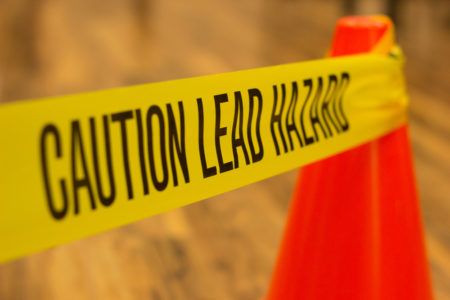If you’re a contractor seeking to remediate the presence of lead in residential or commercial properties, you should understand the difference between lead abatement and lead renovation, repair, and painting (RRP). While the two terms are similar in some respects, misrepresenting the work as one rather than the other can have serious and costly consequences for your contracting business.
What Is Lead Abatement?
Lead abatement is work that is performed with the intent of permanently removing the threat of lead from a home. It is work that is overseen by a government agency and is usually initiated when lead is identified in a property being financed by the U.S. Department of Housing and Urban Development (HUD).
Lead abatement work may also be performed when a property has received a lead violation from the federal Environmental Protection Agency (EPA) or a state or local housing agency. If a child is found to have elevated lead levels, pediatricians will report the results to local health agencies, which will also initiate lead abatement work.
Lead abatement work can only be performed by those specifically trained and certified in lead removal. When lead abatement work is completed, the property owner can rest assured that the home or property is, in fact, lead-free. The same cannot be said for lead RRP work.
What Is Lead RRP?

Lead RRP work consists of any renovation, repair, and painting work in a home built before 1978, where pre-existing lead-based paint may be disturbed as a result. Such work may have nothing to do with the lead in the building itself. For example, a contractor may replace a faulty sink. By removing the old one, they may disturb the lead-based paint surrounding it.
In pre-1978 homes, contractors must follow certain procedures to minimize the threat of lead when performing their renovations, repairs, or painting. Those performing this kind of work also must be trained and certified.
If you perform either lead abatement or lead RRP work without the appropriate training and certification, you and your company may face significant fines and other legal or regulatory action.
What Are the Compliance Requirements for Lead Abatement?
As one might expect, the compliance requirements for lead abatement work are stricter than those for lead RRP work. To perform lead abatement work, one individual must become a Certified Lead Supervisor. Employees working under the Supervisor must be certified as a Lead Worker.
When performing lead abatement work, contractors must take the following steps to comply with relevant regulations:
- Prepare and submit a Pre-Abatement Notification to the EPA or local state agency
- Draft an Occupant Protection Plan
- Have a third party Lead Inspector or Risk Assessor check for lead dust
- Create a Lead Abatement Final report and attest to the property’s lead-free status
In addition, the Certified Lead Supervisor must be onsite when any lead abatement work is performed.
What Are the Lead RRP Compliance Requirements?
However, when a certified firm or contractor performs lead RRP work, they must follow different rules to remain in compliance. For example, they do not need to notify any government agency that they are performing lead RRP work, nor do they need to have their certified staff onsite the entire time.
To be in compliance, a firm must have one employee certified as a Lead Renovator. The Lead Renovator must perform a cleaning verification procedure to ensure that RRP work has not elevated the threat of lead. They also must submit lead test results to the client within 30 days of sending them an invoice and a written checklist of lead safety and cleaning measures undertaken.
The Lead Renovator must be onsite to ensure that any lead that may be disturbed is contained. So, if a contractor is renovating a lead-free area of the building, the Lead Renovator does not need to be onsite. However, the Lead Renovator also needs to be onsite for the final cleanup.
Finally, to be in compliance, lead RRP certified firms must distribute the EPA’s “The Lead-Safe Certified Guide to Renovate Right” pamphlet to clients. The pamphlet discloses to consumers what they need to know about the potential risks they and other occupants face as they perform this work in their homes.
What Are the Lead Abatement and Lead RRP Training and Certification Requirements?
The EPA has established basic requirements for certification that every contractor across the country must follow. However, various states have established their own additional requirements. Before you start, check your local environmental protection agency to learn about any state-specific requirements you may need to follow.
As for the federal requirements to become a Certified Lead Supervisor, you must possess at least, at minimum, one of the following:
- One year of experience as a licensed lead worker,
- One year of experience in the childhood lead poisoning prevention program of a government agency
- Two years of experience in general commercial construction trades or environmental remediation
You also must complete a 32-hour EPA-approved training course. These experience requirements are not required to become a certified Lead Worker or Lead Renovator. However, you will need to take a 16-hour course to become a certified Lead Abatement Worker and 8 hours to become a certified Lead Renovator.
Upon completing your coursework, you must complete and pass a third-party exam that tests your knowledge of lead abatement work and procedures within six months. You’ll need to submit a formal application for the EPA certification that includes proof of your coursework and test results after you pass.

How Can I Receive Lead Abatement or Lead RRP Certification?
If you’re a residential contractor looking to build your business, you want to obtain certification to perform lead abatement or lead RRP work as soon as possible. Performing such work without a license can be costly, with maximum penalties for a first offense including up to a $200,000 fine (plus court costs) and up to a year in prison.
But beyond the penalties, it’s hard to grow your business without such certification. Even if you don’t plan to perform lead abatement work, by forgoing lead RRP certification, you won’t be able to work in homes built before 1978. That means you’ll be ignoring a large group of potential Minnesota customers to avoid taking a day to take a course and sit for an exam.
If certification seems complicated, we at ZOTApro are here to make it easy for you. We offer EPA-approved lead certification courses in English and Spanish that you can take in person or online. We can teach you what you need to pass your test the first time and get your certification application approved.
Contact us today to learn more about our EPA-approved lead certification classes or one of our other 700+ classes for contractors just like you.


